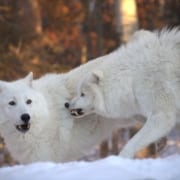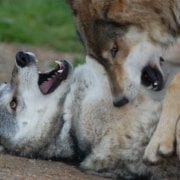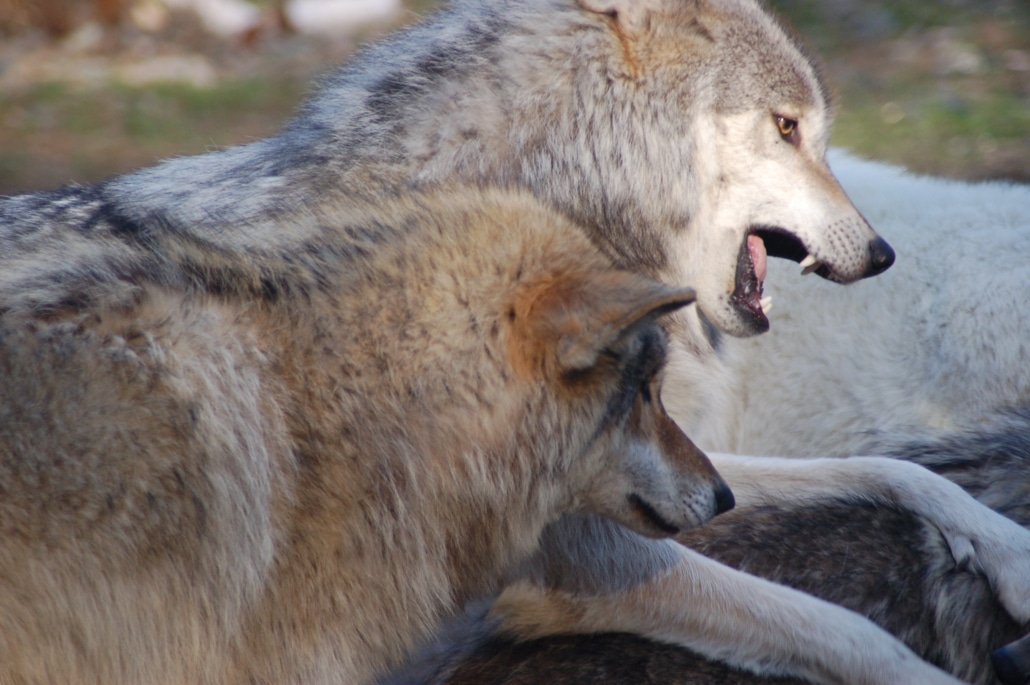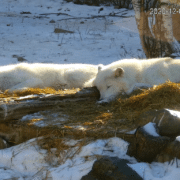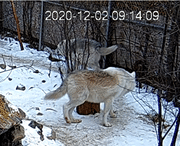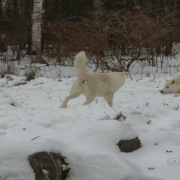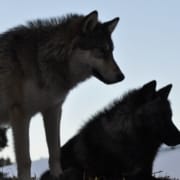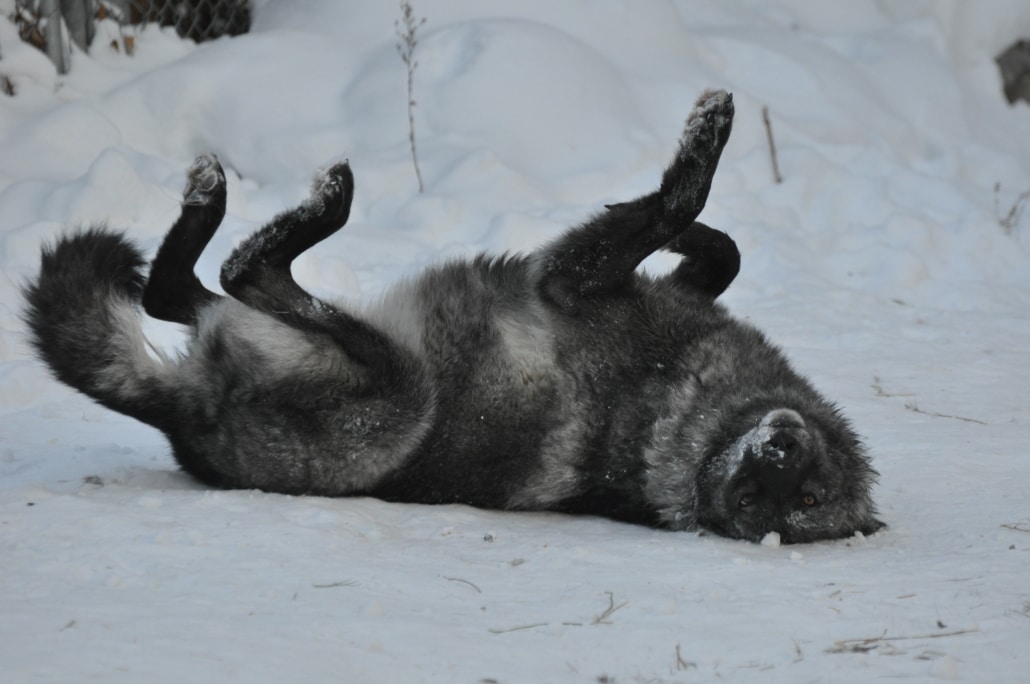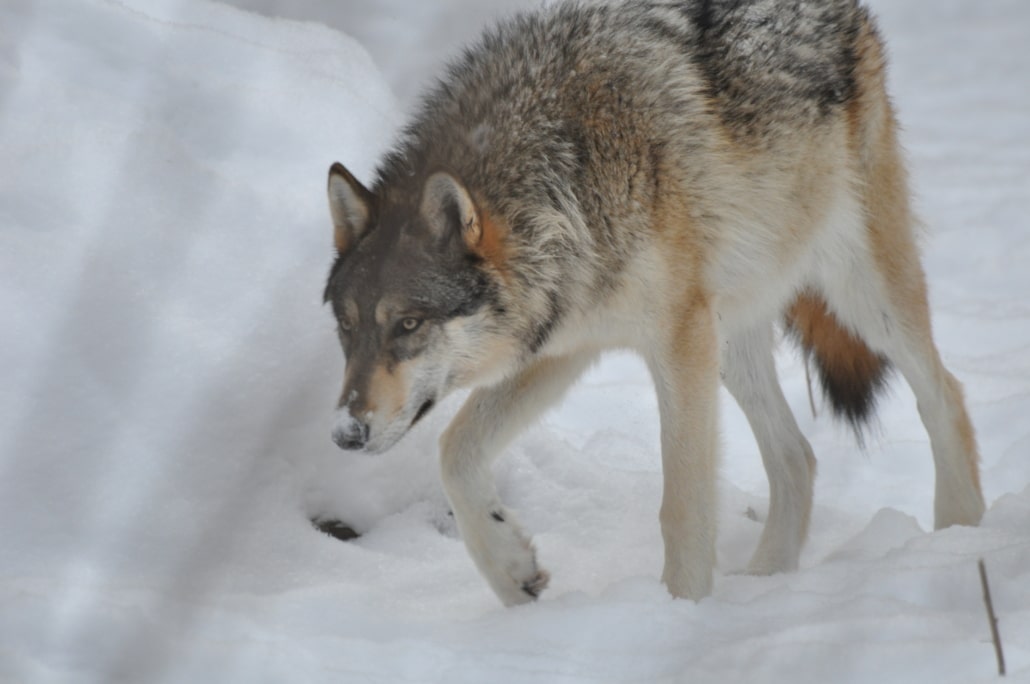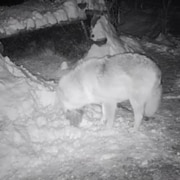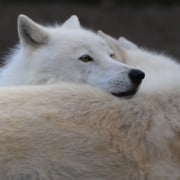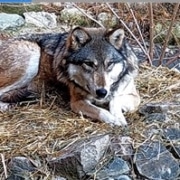Winter is officially here on December 21st, although snow and cold arrived in October. Wolves tend to increase dominance during this seasonal change and in the months to come, we expect more dynamic interactions. This is typically a time of posturing tails, barring teeth and loud vocalizations that is part of wolf communication. In this week’s image, there’s several things to notice. Grayson (on the right) has his lip curled over his canine, his ears pricked forward, but slightly turned to the side in intimidation and his hackles are raised. This is a pretty direct threat display that catches Axel off guard a bit as indicated his his ears turned in a more sideways position. While this may look like they are fighting, this method of expressing dominance makes it clear which wolf is higher ranking and actually avoids more scuffles for rank. With this small social group of two brothers, Axel is the more dominant wolf, but as we make plans to adopt pups and add to the pack in 2021, there may be opportunities for rank to change. Time will tell, but for now, staff record data and photograph and track the communication.
Archives
We have seen an increase in social behavior between Grizzer and Denali. Originally, when Denali was first retired, the bite wound on his paw caused him some discomfort and he wasn’t in much of a mood to interact. As he physically started to heal, we started to see a transformation in his behavior as well. At first, we saw more interest in feeding with Grizzer, then we found them resting near each other. One afternoon, we saw Denali approach Grizzer, getting him up for an enclosure walk. In the last few weeks, there is far more than walking. They have been play bowing, pouncing, running and tail wagging(their latest video is on our recent youtube). It is great to see Denali back to this social behavior and good to see Grizzer keeping his mobility at 16.5 years old. In honor of this activity, I am sharing an image of their past social interaction. They have been pouncing, running and tail wagging for years and while we don’t know how much time they have, we know that each day will be filled with social behavior.
Grizzer and Denali as former Exhibit Packmates
This week’s image was captured by Michelle Wagner from the Center’s Exhibit Webcam. While we had snow early in the season, the recent dry spell has left ground frozen with no insulating value in the snow. To make our wolves comfortable, we provide a layer of straw that insulates from the cold and the darker color absorbs the winter sun. Axel is on the right and Grayson is on the left in this photo. Recently, we fed a deer hide as an enrichment for the wolves and Grayson spend a fair amount of time plucking the hair from the hide and layered his straw bed with deer hair. It certainly added an additional layer of comfort to the bed.
We started feeding the retirees a deer leg on the weekends in addition to their regular diet. This extra food supply has some additional behavioral benefits such as caching, defending food, carrying their possession and overall fulfilling the need of a carnivore. But, as a special addition to these behaviors, the added food stimuli seemed to increase the social interactions between Grizzer and Denali bringing a hop back to their aging steps. This is particularly rewarding to watch on Grizzer who has been struggling with some aging tendons in the last few weeks. There is some truth to the advice that keeping active can improve mobility. To see these two in action, check out this week’s Youtube posted at www.wolf.org
In conjunction with our webcam partners – Explore.org, I have started a new focus for our wolf logs. Each week, I will be selecting an image from the Explore.org gallery that provides a glimpse into the lives of the Axel and Grayson in the Exhibit Pack. This week’s photo caught my attention with Grayson on the left displaying a “T-1 Tail” indicating some heighted arousal while Axel displays a “Play-Bow”, going down on his front legs to spring up to engage or run the other way stimulating a behavior we call “Invite Chase”. I also see that Axel’s tail is over his back as well indicating that he’s feeling pretty confident as well. We certainly have witnessed Grayson gaining a bit more confidence since Denali was retired. Anyone who watched the webcams or visited the Center during the “What’s for Dinner” program witnessed Denali charging Grayson off the carcass, giving Axel preferential treatment. Without much effort, Axel was dominant over Grayson. Now that it’s just the two of them, Axel is working on asserting himself with more frequency and more effort. Behaviors such as this week’s photo are to be expected as each wolf tries to find their place without the influence of other pack members. Other behaviors may include a Chin Rest – T- Block, Following, Chasing, Ride-Up and Avert Gaze. All of these behaviors can be found in our Ethogram list of behaviors. As the winter advances, we expect activity to increase and with the anticipated addition of pups next summer, we expect the posturing for leadership will settle into a more defined structure.
There were no significant findings on the nerve/muscle biopsy that was sent to the University of California- San Diego. The brain and spine showed no lesions that would have caused the neurological condition. This confirms the information that we gained by doing the MRI and spinal tap, which in itself is a significant component of this case as Boltz was the first wolf in our history that had both procedures. The pathologist final report is yet to arrive. I would say we had the best diagnostic team possible, but if I go back to the original discussion about Degenerative Myelopathy, the idea was, that if we ruled everything else out, that’s the likely cause. The DNA test that we ran on Boltz showed the lack of the mutated gene for DM. What I didn’t know (and now I do), is that the lack of the mutated gene wasn’t a diagnosis for DM but was indicative of a an animal being a carrier, not whether an animal had DM. Our loss of Boltz is still fresh in our hearts. The passing of each wolf is hard, but the lack of knowledge on the cause makes this particularly hard for staff.
Today, we take the time to remember Boltz, his legacy of knowledge and medical diagnosis that was a first for any of our wolves. We also take today to honor Luna, who lost her battle to cancer on November 26, 2019.
RIP to these two, it was an honor to be one of your many social companions.
In an effort to give Denali and Grizzer some additional enrichment, we chose to feed them 2 deer legs on Saturday night. We knew that Denali might be more food possessive, but with he and Grizzer both getting a daily meal of between 3 – 4 pounds of meat, we thought the added food could be enjoyed by both. While Denali managed to gather both deer legs on the initial delivery, Grizzer was able to eat some of the meat and proved that he is still capable of guarding food (check out our latest youtube to see him in action). This was great stimuli for Grizzer and a good distraction for Denali who is still not quite settled into retirement. We have noticed that Denali is standing on top of the dens trying to see over the fences into the Exhibit. We decided to open the gate in the pack holding area to allow the retirees a full view of the Exhibit Pack. Of course, we reinforced the shared gate with 1/4 plate steel and additional fence panels to avoid any chance that a gate would be compromised. Grizzer likes the ability to see the arctics, but Denali is still a bit intimidated. Grayson has been at the fence with a high tail posture definitely indicating that his rank has increased since Denali’s retirement.
“Grayson went in for the world record of longest chin rests on Axel. Of course Axel responded to this with a drawn out ride up on Grayson. “
Despite an extensive amount of diagnostic testing, research and treatments, Boltz continues to decline from his neurological condition. On his Monday morning vet check, the wolf care staff discussed quality of life issues and efforts are being made to keep him comfortable and calm as the next steps of the USDA Animal Welfare act protocol are addressed.

The International Wolf Center uses science-based education to teach and inspire the world about wolves, their ecology, and the wolf-human relationship.

